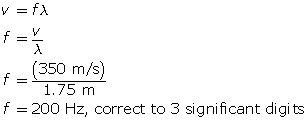Module 8—Mechanical Waves
 Explore
Explore

© Norebbo/shutterstock
Recall that for a mechanical wave, such as sound, the universal wave equation gives the relationship between frequency, wavelength, and speed.
v = fλ
The speed of sound in air varies according to temperature and pressure. If temperature and pressure are constant, the speed of sound is also constant. If you know the speed of sound, the observed frequency of a given wavelength can be derived through a simple application of the universal wave equation. For example, when the speed of sound is 350 m/s, a 1.75-m wave will produce a tone of 200 Hz.

According to this calculation, if the wavelength were to change, the observed frequency would also change. But how would the wavelength change if the object producing it were to start moving?
Wavelength and Frequency of a Moving Source
The Moving Point source: Doppler effect and shock wave simulation will be used to explore what happens to the wavelength of sound when the source of the sound is moving.
 Module 8: Lesson 6 Assignment
Module 8: Lesson 6 Assignment
Remember to submit the answers to TR 1, TR 2, and TR 3 to your teacher as part of your Module 8: Lesson 6 Assignment.
TR 1. Play the simulation by pressing “Start.” Observe the wave fronts produced by the moving object. Recall that wavelength is the distance between each front.
- On which side of the object are the waves compressed?
- Why do they appear compressed only on this side?
TR 2. Reset the simulation, and increase the source speed by dragging out the respective vector arrow. What happens to the leading wavelength as the speed of the source increases?
TR 3. Reset the simulation, and set the source speed to be equal to the speed of sound.
- What is the wavelength of the sound in front of the source when it is travelling at the speed of sound?
- What special name is given to the single wave front when this happens?
According to the universal wave equation, if the wavelength is reduced while the speed of sound remains unchanged, the frequency will increase. Imagine that you are standing stationary and a moving sound source approaches. When the sound source is moving, the leading wave fronts are compressed. According to the universal wave equation the shortened wavelength will produce a higher frequency sound as it approaches a stationary observer. At the same time, the trailing wave fronts are stretched and the longer wavelength produces a lower frequency sound as the source moves past and away from the observer.
 Read
Read
To clarify this concept, read pages 429 and 430 of your physics textbook. Stop at the heading “Analysis of the Doppler Effect.”